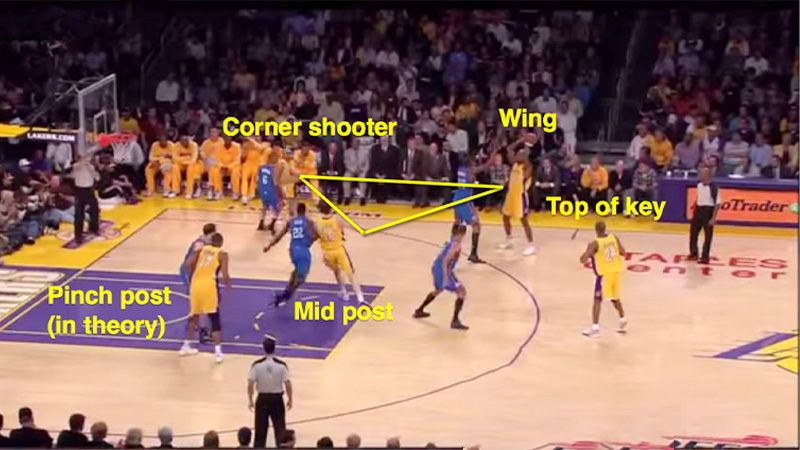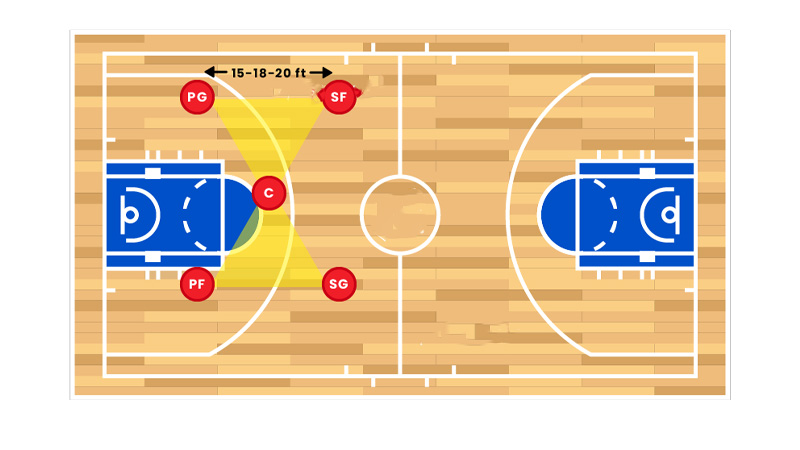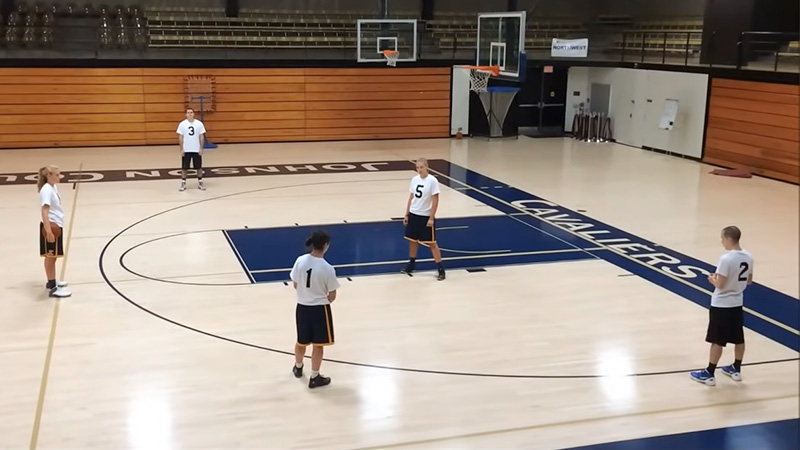The triangle offense in basketball is one of the most popular offenses. Especially, from 1990 to 2010, the Triangle offense earned much of a name!
Going back, you will find multiple victories were delivered by this offensive strategy. Recalling the Chicago Bulls under Jackson. The team earned six championships with the Triangle in the 1990s.
Or, Jackson’s Los Angeles Lakers having five titles with the Triangle. Such examples are not rare.
The triangle offense can be an ideal solution for any coach who wants to develop a solid offense. We are here to guide you today with the triangle offense in basketball.
What is Triangle Offense in Basketball?
You may already know that basketball’s triangle offense is a popular offensive strategy. Many also call it the ‘triple post offense’.
Even though its history with the NBA has not been so favorable, it is still applied to other leagues.
In the triangle, five players build the offense with equal opportunities to score.
Three out of five players develop the core of the offense. They go to the courtside solid and build a sideline triangle.
And, the two other players take positions on the weak side of the court. They play a one-one game here. Mark that, the ball is not in play on the weak side.
Earlier in 1996, many coaches tried to use the triangle offense in order to meet degrees of success.
Some met the triangle offense with success while other basketball experts still believe it to be less effective than modern NBA offensive strategies, which focus more on perimeter shooting and players’ versatility.
Sideline Triangle: The sideline triangle can be set up on either side of the court. It includes a post player on the block and two perimeter players, one in the corner and one on the wing.
Key Points on Triangle Offense:
- In Triangle offense, every pass and cut has a purpose, and the defense controls everything.
- The Triangle offense has proved to be the most ideal way for five players to space out on the basketball court.
- In this formation, players focus to cover up the five spaces and improve player spacing by allowing them to pass to four teammates at once.
- The center creates the sideline triangle in this offense.
- The center takes the low post, the forward has the wing and the guard goes to the corner, this goes for the three players on the strong side.
- Meanwhile, two other guards stand at the top of the key, and the weak-side forward remains on the weak-side high post.
So, how does the triangle offense in basketball work? Find out in the next section.
Positions of Triangle Offense in Basketball

Source: sbnation
It is common to our knowledge that three players take the strong side (Sideline Triangle) while two other players go to the weak side in the offense, setting up a 2-Man Game.
In this part of our article, we will dig a little deeper and find out how to form your team in this lineup.
When you set up this triangle offense, fill up the five key positions within the structure of this offensive strategy.
Position 1: Point Guard
Point Guard (PG) is a common term for regular fans like us. A point guard is usually the primary ball handler and matchmaker of the triangle offense.
He, most often, takes the corner and genuinely starts the offense from the top of the key. After an initial pass, the point guard may move to the wing or corner.
Assign a player with solid ability as a point guard. Especially, look for players who can score the ball, and take shots off the dribble.
It is up to the point guard to start the offense, set up his teammates and take decisions fast based on how the defense might react.
Position 2: The Trigger/ Key
The trigger, perhaps, serves one of the most important purposes in the triangle offense. Also referred to as the Key, a trigger should always start near the perimeter wing.
In general, the trigger should try to feed the low post first. However, you may find the low post often close. In this event, the trigger would pass the ball to the weak side guard, the second.
Keep in mind that the primary job of the trigger is to throw the ball to a teammate so that the offensive play can continue. Plus, he should also pass to one of the other teammates with a certain priority in mind.
To organize all the strategies in the head, you should get a tricky player as the trigger.
Position 3: Post Player
The post players in the triangle offense in basketball are usually the power forward and the center.
The post players at the high post area typically place themselves around the free throw line extended. They are often the power forwards and critical decision-makers of the offense.
On the other hand, post players in the Triangle Offense are expected to be skilled scorers in the low post. They are capable of scoring inside, such as hook shots, drop steps, and turnaround jumpers.
Position 4: The Trail
The trail starts as soon as the team forms the offense. It refers to the top of the key. You can place someone similar to the other guard. Hence, he should be able to score the external shots while running for the dribble also.
Position 5: The Opposite
The fifth position of the Triangle offense is the player in the opposite. Place them on the weak side mid-post (almost a step-off).
In terms of efficiency and strength, the opposite player is similar to our post player on the ball side but should be able to interchange from all positions on the court.
How to Start the Triangle Offense in Basketball?

Source: rookieroad
A quick guide for you to start the triangle offense. If you are a coach, or simply a basketball player in practice, it is a must-learn offense strategy for you.
The triangle offense starts when a guard crosses the wing and makes it to the strong side. To make things comprehensive for you, here is our part-by-part guide for you.
1) Triangle Offense on The Strong Side
You already know that three offensive players move to the strong side of the court where the ball handler is. Five players are around the court in the following alignment,
- Locate the center to the low post area near the basket and away from the free-throw line.
- Have the forward player where the free-throw line extends, at the wing.
- And, the strong side guard will take the corner where the court sideline and baseline merge.
However, as a coach, you must ensure that proper spacing is available in the Triangle offense. For the sideline triangle, players must be fifteen to eighteen feet apart to allow restricted passing.
2) Triangle Offense on The Weak Side
To support the triangle, the remaining two players – the forward and the point guard of the Triangle Offense move to the weak-side corner.
They take Position 1 & Position 5, where the ball is not in play. They play the role of supporting players.
3) Start the Triangle Offense
Pass the ball to the low post player of the sideline triangle and start the Triangle Offense.
Once the offensive strategy starts, players can attempt to score. Meanwhile, the post player passes the ball to any of the strong side players or the team side perimeter players.
4) Shift Post
One crucial step players need to take in Triangle Offensive is passing the ball to the perimeter player to move the match forward.
However, if this is not possible, offensive players can shift sides.
It starts with the strong side wing forward guarding the corner guard, and the weak side guard shifts to the corner of the strong side.
This is done because it offers better opportunities to score. For example, a hand-off ball, pick-and-roll ball, or simply a field goal are all possible goal attempts by the ball hander or the forward.
Case 3: when none of the options are available, suggest your wing and corner go to the basket and perform a backdoor cut. It will open up new doors to shot opportunities.
Backdoor Cut:
Most often used by offensive players, to prevent a pass from the outside to the wing. Backdoor cuts can reduce the pressure on the wing.
What is The Line of Deployment?
The line of deployment in basketball is a genuine concept of the Triangle Offense in Basketball.
To take leverage of the post and have the right pass at the beginning of the offense, all players must get familiar with the line of deployment.
It is simply a straight line between the low post player, the trigger, and the basket. Experts believe the line of deployment makes the defenders stay and play behind the post player.
It starts when the trigger makes a simple move and easily passes the ball to the low-post player without any defense.
It can trigger three events,
- A post defender will be deployed when he selects the front or half-front of the low post. Make your moves smart and you can have potential scoring opportunities in the low post.
- However, if it comes from the high side, the ball handler (trigger) will pass the ball to the corner and then the corner shall pass inside.
- The trigger shall pass the ball to the top and the top to the inside when a defender half-fronts from the low side.
A smart low post player can be a game-changer for you. Thus, make your selection wisely. An outstanding offense can deliver a lot of potential scoring opportunities near the rim.
Benefits of the Triangle Offense
Here are some reasons why you should train your players to develop the triangle offense.
1) Tough on the Defenders
Triangle offense requires players to keep the ball moving continuously.
Players often involve themselves in frequent passing and cutting the ball. It opens up more doors to score and take field goal attempts.
This seamless motion is tough for defenders. They can hardly predict offensive actions, or prevent the offense from scoring.
2) Exchange Positions
All five positions in this offense are interchangeable, meaning, players can shift their position with another player in the offense to increase the efficiency of the formation.
For example, the center may often cover the low post. In case the coach thinks, repositioning can help improve the pace of the game, he can replace him out of the low post as needed.
For years, the triangle offense has proven to be extremely important to improve the capability and versatility of the players.
3) Spacing is Right
The triangle formation allows air between the players. On the solid courtside, there is the sideline triangle, while the other two players take place on the weak side.
The rule is set up! Players have to be at least fifteen to eighteen feet apart from each other in each formation.
The adequate spacing on the triangle offense prevents players’ blockage. Defenders can hardly double-team or involve in unnecessary engagement with the ball handler.
4) Increase IQ
The triangle offense in basketball helps develop different strategies of basketball and be more tactical on the court.
Players need to read and understand the defensive players on every move from their step, body language, and even coordination of their eyes.
Thus, learning the offense also means you get a better chance to improve your move and steps with the basketball.
5) Player Involvement
One of the bonus points of the triangle offense is that all five players on the court are involved in the action.
The strategy doesn’t rely on a single superstar heavily, and every player has the chance to contribute to the offense and make decisions.
Plus, the triangle offense can adapt to suit different player strengths and skills. You have both inside and outside scoring options, effective against various defensive strategies.
Drawbacks of the Triangle Offense
Like a coin, every action has two sides. Let’s take a look at what are the drawbacks of triangle offense, you should be aware of.
1) Not so Easy
The triangle offense can be a hard strategy to knack. It requires players to thoroughly understand the principles and reads involved.
It takes time and hard practice to apply the offense effectively and can be often challenging for new players or teams to grasp initially.
2) Fast-Break Opportunities Limited
This offensive strategy sets the ball in motion. However, it can, often, slow down the speed of the game and reduce fast-break opportunities.
If you don’t handle it right, it might be disadvantageous for teams with particularly athletic and fast players, thriving in a transition game.
3) Rely on Post Play
While post-play can be a strength of the triangle offense, it can also be a limitation if a team lacks dominant post players.
Today, in the NBA, where three-point shooting and perimeter play is in the spotlight, the offense may not suit teams without skilled post scorers.
4) Proper Coaching
The triangle offense effectively demands a coach who thoroughly understands the strategy and can communicate its ins and outs to the players.
It may be challenging to find coaches experienced in the triangle, limiting the number of teams that can effectively apply the offense.
Last Words
Congratulations! We are here at the end of our 2000 words long article.
If you have gone through our article fully, you must already develop a basic idea of triangle offense in basketball.
The offense may seem tough to deal with based on the levels of strength and potential required from a player.
But with the right coaching and proper mentoring, you can train your players to deliver effective triangle strategy to the court that can open up more scoring opportunities for you.
Do you like our article? If yes, don’t forget to share it with your friends.







